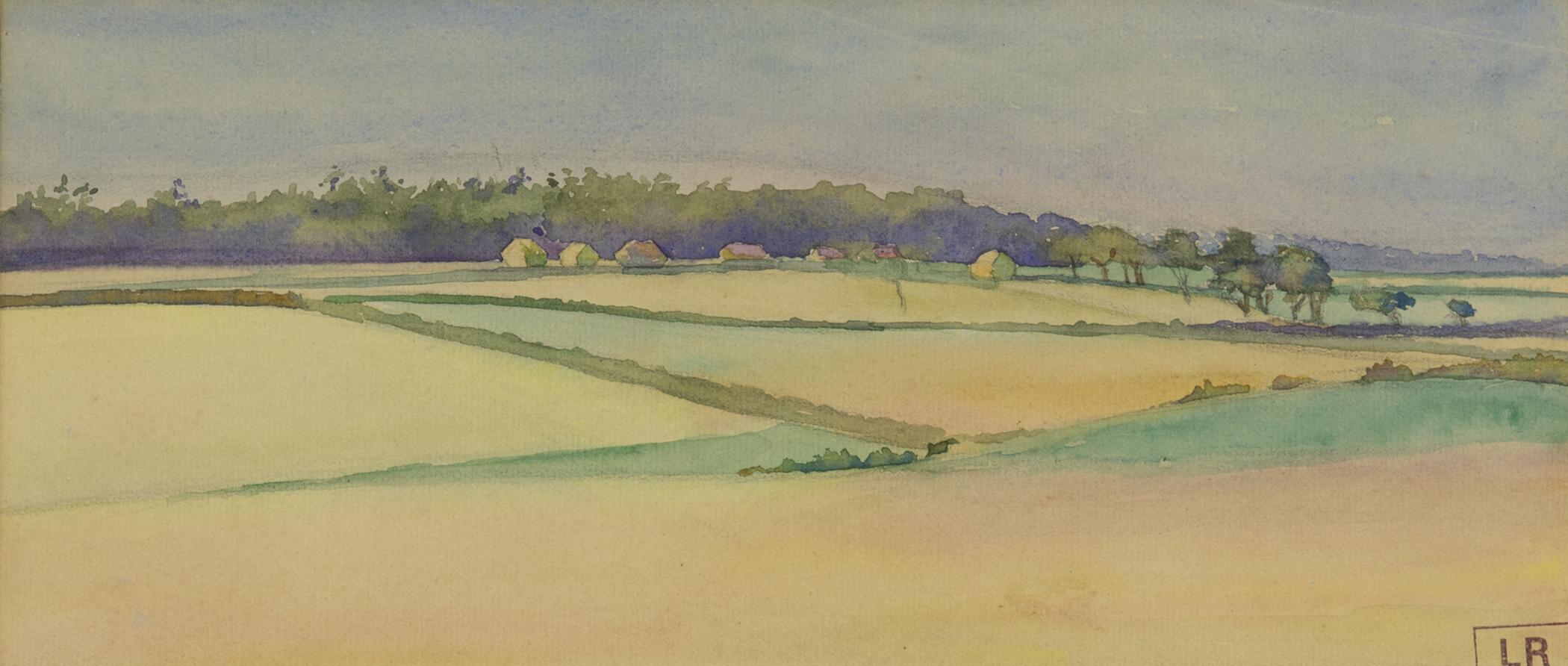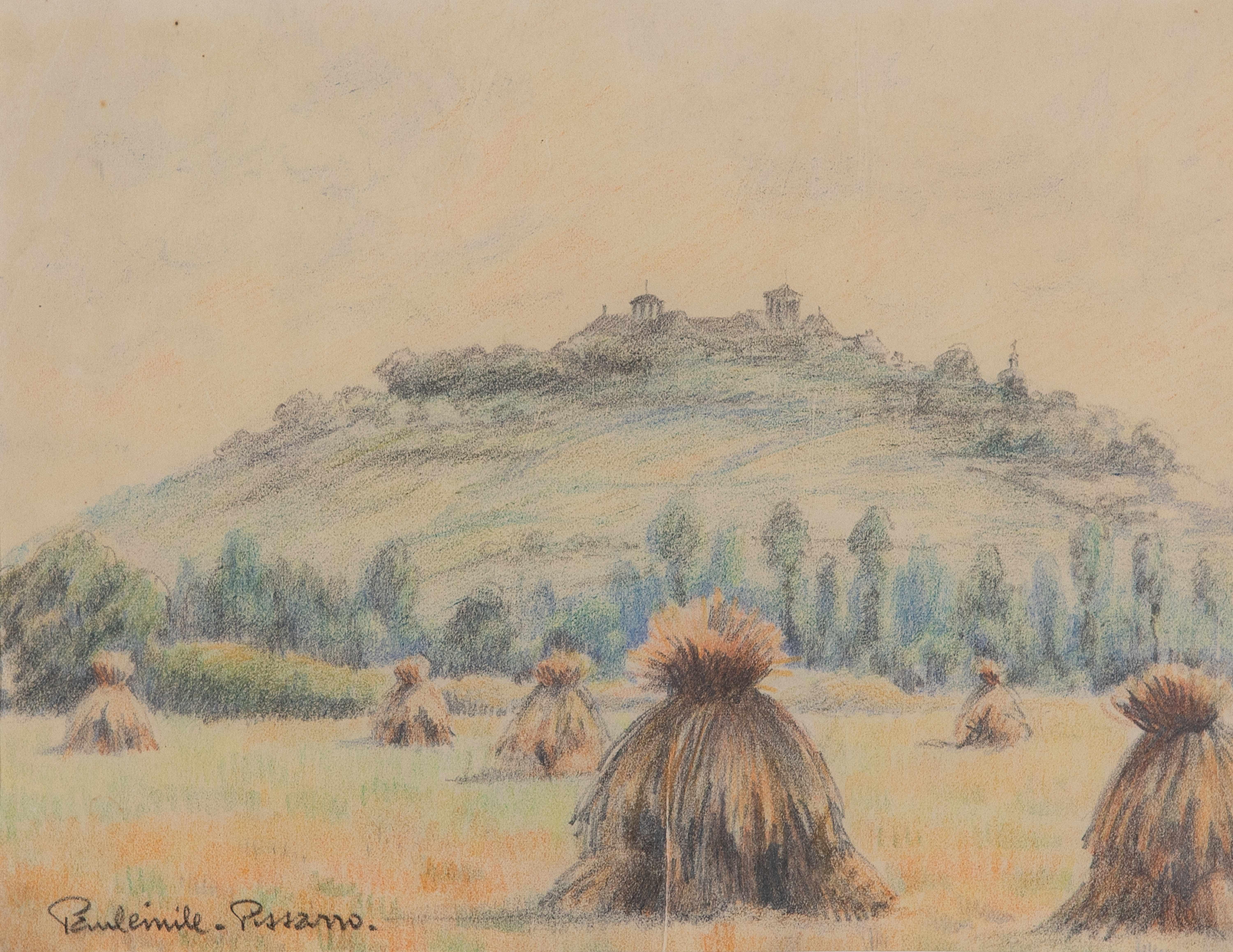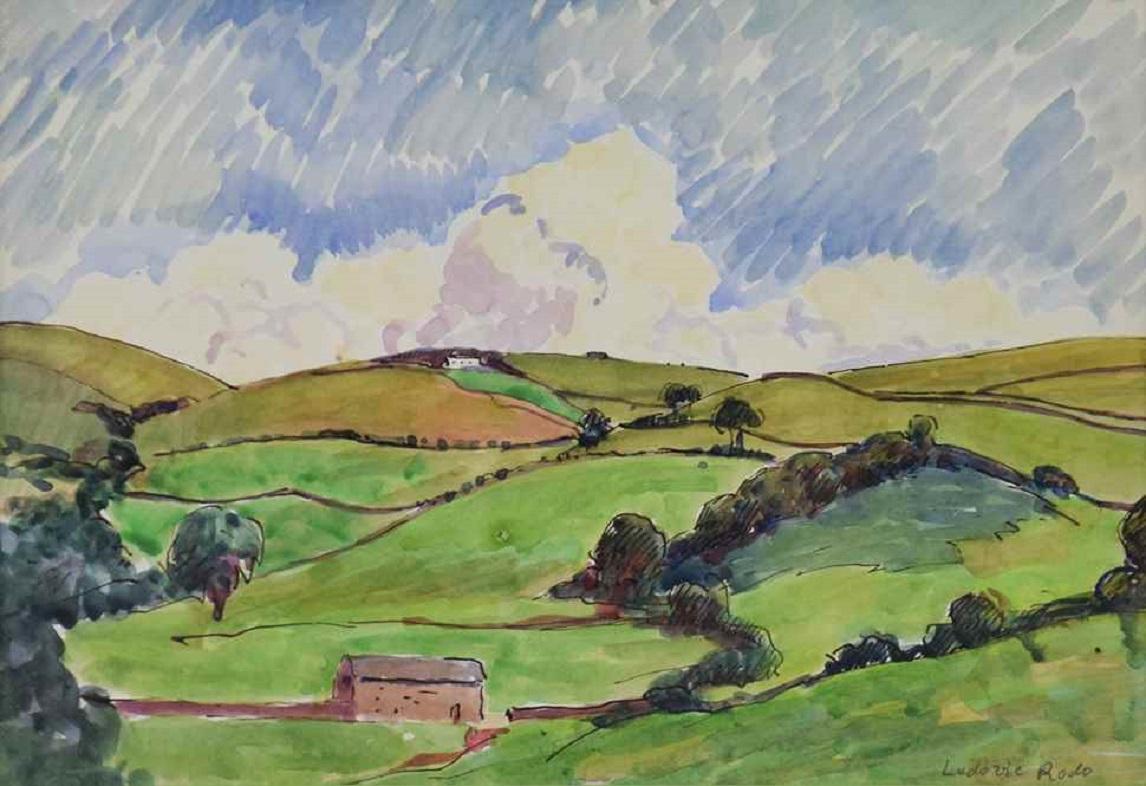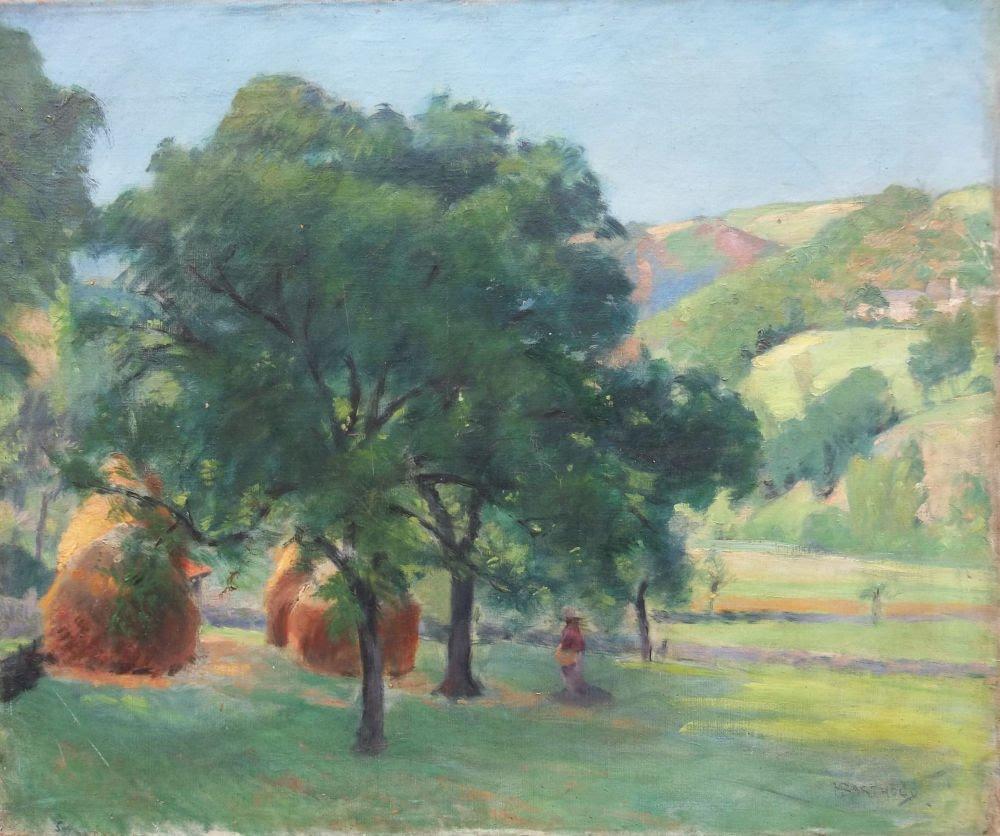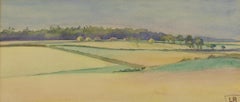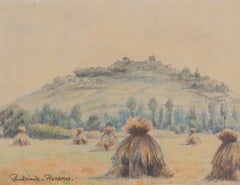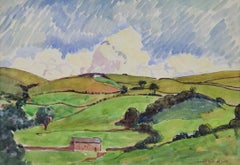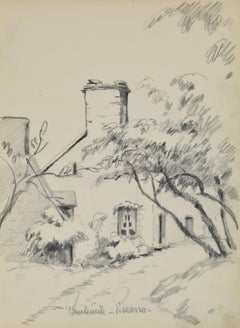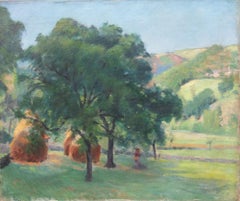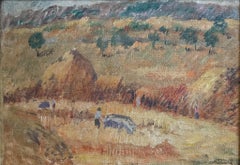Items Similar to Haystacks, Eragny by Lucien Pissarro - Landscape, Work on paper
Want more images or videos?
Request additional images or videos from the seller
1 of 4
Lucien PissarroHaystacks, Eragny by Lucien Pissarro - Landscape, Work on paper1921
1921
$8,806.57
£6,500
€7,605.65
CA$12,131.63
A$13,586.66
CHF 7,089.30
MX$165,955.24
NOK 90,196.50
SEK 85,021.01
DKK 56,760.06
About the Item
Haystacks, Eragny by Lucien Pissarro (1863-1944)
Ink and coloured crayon on paper
11 x 19.5 cm (4 ³/₈ x 7 ⁵/₈ inches)
Signed with the monogram and dated lower left, Eragny 1921
This work is accompanied by a letter of authenticity from Colin Harrison, Senior Curator of European Art at the Ashmolean Museum, Oxford.
Provenance: Private collection, UK
The subject of this work is one he associated with his parents' home at Eragny-sur-Epte, where he had painted it several times in the early years of the twentieth century. This drawing was made during Lucien's stay divided between Paris and Eragny between 19 June and approximately 25 July 1921, while he was working on an edition of his father's correspondence.
Artist biography:
Born on the 20th February 1863, Lucien Pissarro was the eldest son of the Impressionist painter Camille Pissarro. Coached from a young age by his father and in the frequent company of figures such as Cézanne, Gauguin and Monet, it is no surprise that Lucien chose to pursue an artistic career. While he is best known as a landscape painter, Lucien was also a printmaker, wood engraver and printer of fine books, occasionally painting still lifes and portraits of his family.
Lucien first visited England in 1870 with his family when fleeing the Franco-Prussian war. It was the beginning of a great love affair with the country. He decided to move permanently to England in 1890, becoming an English citizen in 1916. Until then he had worked as a landscape painter and book illustrator in France. During this period he met and worked with painters such as Paul Signac, Georges Seurat and Vincent van Gogh. Moving simultaneously in Impressionist and Neo-Impressionist circles, Lucien exhibited Pointillist paintings with his father in the last Impressionist exhibition in 1886. In the same year he was one of the first artists to exhibit in the “Salon des Indépendants” as a Neo-Impressionist.
Despite his close relationship with his father, as revealed in their correspondence, Lucien showed remarkable independence of mind in his approach to his art. While Lucien was trained by his father, the influence the artists had on one another was reciprocal. Thanks to his relationship with Seurat and Signac, Lucien encouraged Camille to experiment with Pointillism, a characteristic of the Neo-Impressionist group.
Lucien’s move to England in 1890 allowed him greater freedom to pursue his interest in book illustration and printing. There Lucien and his wife Esther established the Éragny Press, named after the Normandy village where his family lived since 1884. The Éragny Press was principally notable for creating aesthetically pleasing books and paved the way for the development of European book art. Lucien’s illustrations for these books demonstrate his talent and command of colour.
Nevertheless, Lucien always considered painting his primary concern, particularly landscape painting. Continuing the tradition of the Impressionists, Lucien was a plein-air painter who liked to work outdoors and study the subject directly from nature. His landscapes reveal his fascination for the effects of weather and light. The contemporary art critic Frank Rutter described Lucien as a master of colour, writing in 1922: “there is no man living who has a more profound knowledge of the science of colour, or a more discriminating eye for its observation in nature.” Rutter was also struck by Lucien’s respect for his subject, nature itself: “Each canvas is wrought with a quiet perfection that conceals its art and is eloquent of the tender emotion which the loveliness of nature inspires in the artist.”
It is clear from Rutter’s praise that Lucien’s contemporaries were impressed by his combination of English and French artistic traditions. Unsurprisingly, he became associated with artistic groups that drew inspiration from the Impressionists, including the New English Art Club, with whom he exhibited in 1904, the Fitzroy Street Group in 1907 and the Camden Town Group in 1911. To his English contemporaries Lucien represented a direct link to the Impressionist Masters. His influence can be recognised in the work of British artists such as Spencer Gore, Harold Gilman and Walter Sickert, who acknowledged Lucien’s influence, writing in 1914: “Mr Pissarro, holding the exceptional position at once of an original talent, and of the pupil of his father, the authoritative depository of a mass of inherited knowledge and experience, has certainly served us as a guide.”
Since his first solo exhibition at the Carfax Gallery in May 1913, Lucien Pissarro’s work has been featured in countless exhibitions and galleries. During his lifetime Lucien donated his estate to the Ashmolean museum in Oxford, where a permanent collection of his work is still housed today. His works are featured in every major art museum in England, as well as the Musée d’Orsay in Paris, the National Gallery of Australia and many museums in the USA.
- Creator:Lucien Pissarro (1863 - 1944, French)
- Creation Year:1921
- Dimensions:Height: 4.34 in (11 cm)Width: 6.7 in (17 cm)
- Medium:
- Movement & Style:
- Period:
- Condition:
- Gallery Location:London, GB
- Reference Number:1stDibs: LU261216356242
About the Seller
5.0
Recognized Seller
These prestigious sellers are industry leaders and represent the highest echelon for item quality and design.
Established in 1964
1stDibs seller since 2015
103 sales on 1stDibs
Typical response time: 7 hours
Associations
Society Of London Art Dealers
- ShippingRetrieving quote...Shipping from: London, United Kingdom
- Return Policy
Authenticity Guarantee
In the unlikely event there’s an issue with an item’s authenticity, contact us within 1 year for a full refund. DetailsMoney-Back Guarantee
If your item is not as described, is damaged in transit, or does not arrive, contact us within 7 days for a full refund. Details24-Hour Cancellation
You have a 24-hour grace period in which to reconsider your purchase, with no questions asked.Vetted Professional Sellers
Our world-class sellers must adhere to strict standards for service and quality, maintaining the integrity of our listings.Price-Match Guarantee
If you find that a seller listed the same item for a lower price elsewhere, we’ll match it.Trusted Global Delivery
Our best-in-class carrier network provides specialized shipping options worldwide, including custom delivery.More From This Seller
View AllLandscape with Haystacks by Ludovic-Rodo Pissarro - Watercolour
By Ludovic-Rodo Pissarro
Located in London, GB
Landscape with Haystacks by Ludovic-Rodo Pissarro (1878-1952)
Watercolour on paper
15 x 34 cm (5 ⁷/₈ x 13 ³/₈ inches)
Signed with Estate stamp (initials) lower right, LR
an early wor...
Category
Early 1900s Figurative Drawings and Watercolors
Materials
Paper, Watercolor
Meules de foin by Paulémile Pissarro - Landscape drawing
By Paul Emile Pissarro
Located in London, GB
Meules de foin by Paulémile Pissarro (1884-1972)
Graphite and coloured crayon on paper
19.5 x 25 cm (7 ⁵/₈ x 9 ⁷/₈ inches)
Signed lower left, Paulémile. Pissarro.
This work is accom...
Category
20th Century Post-Impressionist Mixed Media
Materials
Paper, Crayon, Graphite
Paysage, Watercolour on Paper Painting by Ludovic-Rodo Pissarro, circa 1920
By Ludovic-Rodo Pissarro
Located in London, GB
Paysage by Ludovic-Rodo Pissarro (1878 - 1952)
Watercolour on paper
28 x 36 cm (11 x 14 ⅛ inches)
Signed lower right, Ludovic Rodo
Executed circa 1920
This work is accompanied by a...
Category
1920s Impressionist Landscape Drawings and Watercolors
Materials
Paper, Watercolor
Paysage by Paulémile Pissarro, circa 1934 - graphite on paper
Located in London, GB
ARTWORK SOLD UNFRAMED
Paysage by Paulémile Pissarro (1884 - 1972)
Graphite on paper
32 x 23.5 cm (12 ⁵/₈ x 9 ¹/₄ inches)
Signed lower middle, Paulémile-Pissarro-
Executed circa 1934...
Category
1930s Post-Impressionist Drawings and Watercolor Paintings
Materials
Paper, Graphite
Paysage by Paulémile Pissarro - Landscape drawing
By Paul Emile Pissarro
Located in London, GB
SOLD UNFRAMED
Paysage by Paulémile Pissarro (1884-1972)
Pencil on paper
12.7 x 19.7 cm (5 x 7 ³/₄ inches)
Signed lower left, Paulémile Pissarro
Provenance
Estate of the artist
Yvo...
Category
20th Century Post-Impressionist Landscape Drawings and Watercolors
Materials
Paper, Graphite
Paysage en Normandie by Georges Manzana Pissarro - Charcoal landscape
By Georges Henri Manzana Pissarro
Located in London, GB
Paysage en Normandie by Georges Manzana Pissarro (1871-1961)
Charcoal on paper
32 x 39 cm (12 ⅝ x 15 ⅜ inches)
Stamped lower right, Manzana Pissarro
Executed circa 1930
Artist biogr...
Category
1930s Post-Impressionist Landscape Drawings and Watercolors
Materials
Paper, Charcoal
You May Also Like
Haystacks near Palaiseau - Original handsigned lithograph - 100 copies
By Armand Guillaumin
Located in Paris, IDF
Armand GUILLAUMIN
Haystacks near Palaiseau (Les Meules en hiver à Palaiseau), c. 1898
Original lithograph
Handsigned in ink bottom left
Limited to 100 copies ; this one bears ...
Category
1890s Post-Impressionist Landscape Prints
Materials
Lithograph
Haystacks in a French Village Antique French Impressionist Oil Painting
Located in Cirencester, Gloucestershire
Haystacks in a French Village
Paul Molinard 19/20th Century French Artist
signed oil on board, unframed
board : 10.5 x 14.5 inches
Inscribed verso
Provenance: private collection, Fr...
Category
Early 20th Century Impressionist Landscape Paintings
Materials
Oil
Haystacks
By Manuel Barthold
Located in Norwich, GB
Haystacks, ca 1910, by Manuel Barthold (1874- 1947)
This charming and peaceful rural scene was painted probably in Brittany,. With its pure colour and feel of immediacy, it is styli...
Category
Early 20th Century Impressionist Landscape Paintings
Materials
Oil
Haystacks
By Abraham Walkowitz
Located in New York, NY
Haystacks by Abraham Walkowitz (1878-1965)
Oil on canvas
14 x 20 inches unframed (35.56 x 50.8 cm)
19 ½ x 25 ½ inches framed (49.53 x 64.77 cm)
Signed on lower right
Description:
Ab...
Category
20th Century American Impressionist Landscape Paintings
Materials
Oil
Price Upon Request
Haystacks in a Sunlit Filed Rural Summer Landscape Oil Painting
By Fanch Lel
Located in Cirencester, Gloucestershire
Haystack Landscape
signed by Fanch Lel (French b. 1930)
size: 13 x 21.5 inches
oil painting on board, unframed
condition: the painting is in very good condition. It has previously be...
Category
20th Century Impressionist Landscape Paintings
Materials
Oil
19th Century British landscape with haystacks by female artist Robinson
Located in Petworth, West Sussex
Mabel Catherine Robinson (British, b.1875)
Harvesters
Watercolour on paper
Signed ‘M. Robsinson’ (lower right)
6.1/8 x 11in. (15.6 x 28cm.)
Category
19th Century Impressionist Landscape Drawings and Watercolors
Materials
Watercolor
More Ways To Browse
Antique Work Light
Antique Paper Company
Art By Lucien
Antique Paper Press
Monet Drawings
Van Gogh Drawings
Pissarro Signed
French Landscape 1870
George Post Watercolor Paintings
George Post Watercolor
Camille Pissarro Signed
Drew And Sons
Antique Printing Press
Australian Impressionist
Neo Impressionist
Mr Frank
Antique War Club
Antique Book Press
